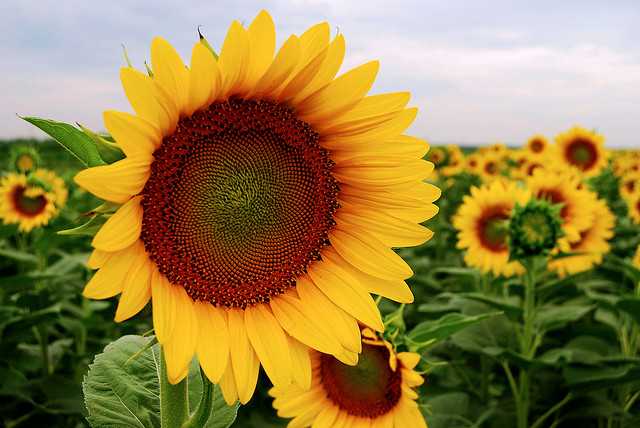
Some people see a Sunflower as a vegetable, while others see it as a flower. It is, of course, both a great vegetable, and a beautiful flower. Attractive, nutritious and healthy, Sunflowers have it all. These are all the reasons why sunflowers have spread from their native home in North America, and now they are grown around the world.
Where to plant
Sunflowers require six to eight hours of sun per day, and for that reason they grow best in locations with direct sun. Sunflowers prefer long, hot summers to flower well. The plants prefer loose, well-dug, well-draining soil, because sunflowers have long tap roots which need to stretch out. In order to ensure the soil is not too compact, dig down two feet in depth and about three feet across when you prepare a bed.
The soil needs to be nutrient-rich with composted manure or organic matter, since sunflowers are heavy feeders. As an alternative, work in a slow release granular fertilizer eight inches deep into the soil. It is also highly recommended that you put seeds in a spot which is sheltered from strong winds, perhaps near a building or along a fence.
How to plant
If you want to plant in rows, then space seeds about six inches apart in a shallow trench between one and two inches deep. Plant two inches deeper if the soil is sandy. Cover and water in next seven to ten days, until seeds sprout. When the second set of leaves appear (First true leaves), thin plants to about two feet apart. Sunflowers will mature and develop seeds in three to four months, depending on the variety. In order to enjoy continuous blooms until the first frost, sow a new row every two to three weeks.
Care
Water around the root zone while the plant is small, about three to four inches from the plant. Water deeply though infrequently once the plant is established to encourage deep rooting. Water once a week with a few gallons of water, unless the weather is exceptionally dry or wet. Over fertilization can cause stems to break in the fall, and for that reason feed plants only sparingly.
You can add diluted fertilizer into the water, even though you should avoid getting the fertilizer near the base of the plant. However, it may be helpful to build a moat in a circle around the plant about eighteen inches out. Support is required by tall species and cultivars. In that case, bamboo stakes are an excellent choice for any plant which has a strong steam and requires support for a short period of time.
Harvest and storage
If you plan to harvest for indoor bouquets, cut the main steam before its flower bud has a chance to open in order to encourage side blooms. If you harvest flowers during middle of the day, it may lead to flower wilting. For that reason, it is recommended that you harvest sunflowers early in the morning. Handle them gently and the flowers should last at least seven days in water at room temperature. Change the water each day to keep sunflowers fresh and arrange them in tall containers which provide good support for their heavy heads.
If you want to harvest seeds, you should keep an eye out for ripeness. The bracts will start to dry and turn brown and the back of the flower will turn from green to yellow. This usually happens about four to six weeks after bloom and seed moisture is about 35%. Normally, seeds are ready for harvest when the head turns brown on the back. Cut the head off the plant and remove the seeds with your fingers. Cover the flowers with a light fabric to protect the seeds from birds.



